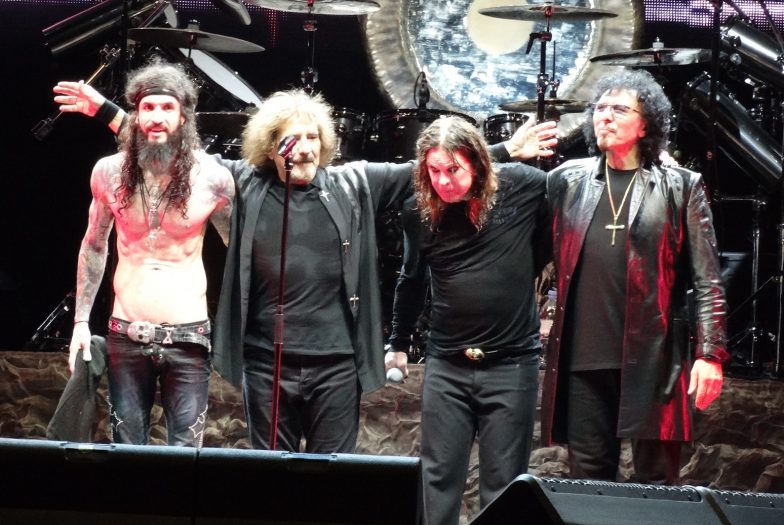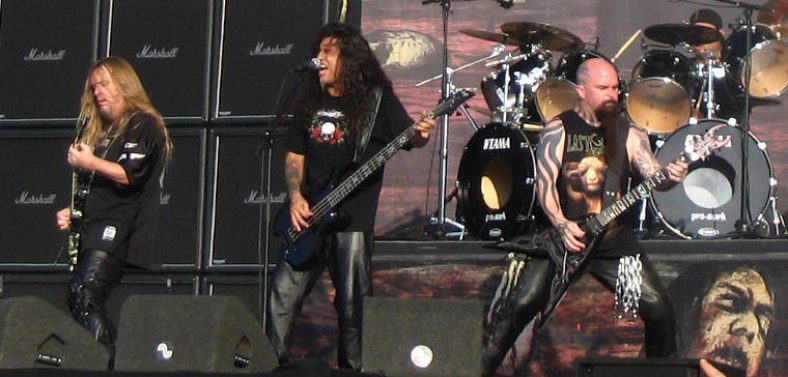The History of Heavy Metal – Origins, Bands, and Early Influences

While heavy metal music “officially” kicked off in 1970, some earlier works of music were the main driver behind the birth of this genre. As heavy metal was born from classic and hard rock music, it shares the same roots with rock, including blues, gospel, country, jazz, and boogie-woogie.
These genres, especially rock music, included various elements such as guitar-heavy riffs, complex chords, and rhythms, as well as distorted sounds that led the heavy metal genre to evolve dramatically throughout its existence. It’s a pretty diverse genre with dozens of subgenres that continued to pop up well into the mid-1990s.
Contents
- Heavy Metal History At A Glance
- What Defines Heavy Metal?
- Why Is It Called Metal Music?
- Music That Inspired the Rise of Metal Music (the 1950s and 1960s)
- Who Was the 1st Heavy Metal Band?
- Tony Iommi Story – Heavy Metal-Style Guitar Playing
- Mainstream Heavy Metal Music from the 1970s
- Early Sub-Genres of Heavy Metal (the 1980s to 2000s)
- Who Are the Big 4 Thrash Metal Bands?
- Recent Sub-Genres of Metal
- Summary
Heavy Metal History At A Glance
- Heavy metal music originated in the late 1960s and shares roots with rock music.
- Key characteristics of heavy metal include loud, distorted guitars, powerful bass, intense drumming, and diverse vocals.
- The genre often explores dark themes and features complex song structures, diverse sub-genres, and distinctive visual aesthetics.
- Early influences came from classic and hard rock, with bands like Black Sabbath and Led Zeppelin at the forefront.
- Black Sabbath is widely credited as the first heavy metal band.
- The 1970s saw the rise of heavy metal with bands like Black Sabbath, Iron Maiden, Deep Purple, and Judas Priest. The era is called “the new wave of British heavy metal,” with British bands pioneering the genre.
- Sub-genres emerged in the 1980s and beyond, including glam metal, progressive metal, black metal, death metal, power metal, and thrash metal.
- The “Big 4” thrash metal bands are Slayer, Metallica, Anthrax, and Megadeth.
- Nu metal and metalcore emerged in the 1990s and remain influential.
- The New Wave of Traditional Heavy Metal revitalized the genre in the 2000s.
- Heavy metal continues to be present, with a dedicated fan base and new bands embracing its legacy.
What Defines Heavy Metal?
Just like any music genre, heavy metal has a unique style that makes it easily identifiable. Since the late 60s, heavy metal has evolved into a diverse and influential style of rock music. It is characterized by its distinctive sound and a number of defining characteristics:
- Loud and Distorted Guitars: One of the most prominent features of heavy metal is the use of heavily distorted electric guitars. The guitar riffs are often powerful, aggressive, and played at high volumes, creating a wall of sound.
- Highly Amplified Bass: The bass guitar in heavy metal is usually played with a deep, powerful tone that complements the guitar riffs and adds to the overall heaviness of the music.
- Powerful Drumming: Heavy metal drummers often use double bass pedals and play with a strong, driving rhythm. The use of fast and intricate drum patterns is common, especially in subgenres like thrash and speed metal. As for the beat, heavy metal songs usually fall within the 120-250 BPM range. But, there are many heavy metal ballads with much lower BPM levels.
- Strong Vocal Style: Heavy metal vocals can vary widely, but they often include powerful and melodic singing, aggressive shouting, or even growling (known as “screaming” or “vocal fry”). Lyrics often explore themes of rebellion, fantasy, mythology, and sometimes darker or more controversial subjects.
- Complex Song Structures: Many heavy metal songs feature complex arrangements with multiple sections, including guitar solos, instrumental breaks, and tempo changes. This complexity adds depth and intrigue to the music.
- Themes and Imagery: Heavy metal musicians often like to explore various topics, including philosophy, life, and mythologies, as well as intense themes, such as the dark, occult, death, war, and social issues. The imagery in heavy metal can be dramatic and include elements of fantasy, science fiction, and horror.
- Diverse Subgenres: Heavy metal has numerous subgenres, each with its own unique characteristics. Some popular subgenres include classic metal, thrash metal, death metal, black metal, power metal, and progressive metal.
- Visual Aesthetics: Heavy metal culture often includes distinctive visual elements, such as leather clothing, studs, spikes, and band logos with intricate, gothic, or fantasy-inspired designs.
Characteristics and Instruments
Metal music is characterized by a fast tempo, heavy distortion, powerful rhythms, and dense guitar and bass sounds.
The instruments used in heavy metal music include electric guitars, bass guitars, and drums. In some metal subgenres, bands may use organs, electronic keyboards, or other instruments.
Style and Themes
The lyrics and themes used in heavy metal songs usually have a dark nature. War, death, depression, remorse, justice, and guilt are some of the most popular themes from which heavy metal music takes inspiration.
However, it’s not uncommon for metal songs to have lighter themes like love or joy. Many heavy metal songs are also classified as power ballads.
On a side note, a few heavy metal bands use themes that revolve around satanism and the worship of the devil. This is why heavy metal music is often associated with the devil. The famous “sign of the horns” hand gesture that metalheads use might just be another reason.
Actually, few people really know that the story of the “sign of the horns” is a gesture to get rid of evil eyes and demons. The gesture was introduced to the rock and heavy metal world by the master singer Ronnie James Dio in 1979. It was a gesture his Italian grandmother was using when Dio was a kid. Dio used it in a concert, and the sign became one of the most enduring symbols of the rock and heavy metal world.
Why Is It Called Metal Music?
There are several stories on how heavy metal music got its name. The American band Steppenwolf used the term for the first time in the lyrics of its “Born To Be Wild” song, as the song has a part saying “heavy metal thunder.”. Others trace the origin of the name to the hippie movement because “heavy” used to be a synonym for “deep” or “profound.”
Another theory is that the name was related to steelmaking because the genre’s pioneers came from cities where the steelmaking industry prevailed. For example, Black Sabbath was founded in Birmingham. Some also think that the genre got this name simply because its sounds are as loud and heavy as metals.
Music That Inspired the Rise of Metal Music (the 1950s and 1960s)
Since heavy metal is a subgenre of rock, it’s a no-brainer that the genre took inspiration from early works of classic and hard rock.
Pieces from the early 1950s that featured heavy guitar riffs sparked the birth of the genre. These songs include Link Wray’s instrumental song “Rumble,” The Kingsmen’s take on “Louie Louie,” and James Cotton’s “Cotton Crop Blues.”
Later on, with the emergence of rock subgenres like acid rock and psychedelic rock, the first roots of heavy metal music came to life. Releases like Cream’s “Fresh Cream” and The Jimi Hendrix Experience’s “Are You Experienced?” inspired Black Sabbath’s early works of heavy metal music.
And even though both psychedelic and acid rock featured heavier sounds than other subgenres of rock, they were nowhere as revolutionary as Black Sabbath’s creations.
In short, heavy metal music was born from the classic and hard rock of the 1960s. As rock music was born as a mixture of blues, gospel, rhythm and blues, country, jump blues, and jazz, in addition to boogie-woogie, the hints of these genres can also be traced to heavy metal music.
Who Was the 1st Heavy Metal Band?
Black Sabbath is generally credited as being the first heavy metal band, and their debut album, “Black Sabbath,” is considered the first full heavy metal album. The band’s lead vocalist, “Ozzy Osbourne,” is often credited for being ”The Godfather of Metal” as he was the lead singer and frontman of the first heavy metal band.

However, there’s another side to that story, where people and critics credit Led Zeppelin for inventing heavy metal music. Among many bands, Led Zeppelin was playing some songs in the late 1960s that can be called “proto-metal,” which also influenced Black Sabbath’s sound. But the variety of Zeppelin songs is huge, and they can’t be labeled as a pure heavy metal band.
Also, other bands, such as Deep Purple, had a pretty solid hard rock sound that sometimes shifted to heavy metal realms. But, the Black Sabbath sound was heavier, darker, and more aggressive, which falls better into the heavy metal category.
So, it can be said that Led Zeppelin and Deep Purple may be called “the grandfathers of heavy metal,” while the fathers are the members of the Black Sabbath.
Both bands made their debuts in the late 1960s and early 1970s, with Black Sabbath releasing their “Black Sabbath” album in February 1970 and Led Zeppelin introducing their “Led Zeppelin” in January 1969.
Those who credit Black Sabbath argue that the band influenced dozens of other metal bands and subgenres that emerged in the following years or even decades. Led Zeppelin had a major influence over the genre, but the band is viewed as more of a hard rock band than a heavy metal one.
Tony Iommi Story – Heavy Metal-Style Guitar Playing
The story of Tony Iommi, the Black Sabbath lead guitarist, also plays a big role in the creation of heavy metal. Tony lost the fingertips of his middle and ring fingers of his right hand while on his last day working in the factory. As he was left-handed, he was using his right-hand fingers on the fretboard. The doctor told him it was not possible to continue playing guitar anymore.
In contrast to many people, Tony Iommi did not give up on playing guitar and started experimenting with plastic fingertips to continue playing. After he made several prosthesis tips and tried them out, he started to create a new style of playing. It was grim, thick, and sweeping. Plus, thanks to the material, the guitar tone was slightly more aggressive. So, that is how the heavy metal style guitar was actually born.
Mainstream Heavy Metal Music from the 1970s
The 70s was indeed a great decade for heavy metal music, with some of the most inspiring pieces being released during that period. The heavy metal genre truly matured in the 70s as it witnessed the formation of high-profile bands like Iron Maiden, Diamond Head, and KISS.
The 70’s rock music is known for many bands from England pioneering the genre. This era is called “ The British Invasion” in rock music history. With heavy metal, there was a similar story as many pioneer bands like Black Sabbath, Led Zeppelin, Deep Purple, Iron Maiden, and so on are from Great Britain. In the heavy metal world, this era is called “the new wave of British heavy metal,” commonly abbreviated as NWOBHM. It officially started in the early 1970’s and went on until mid-1980’s. During this time, many heavy metal bands were from the U.K., dominating the charts and the world.
Bands such as KISS, Aerosmith, and Steppenwolf were from the American continent. There were also bands from different parts of the world, like Scorpions from Germany and AC/DC from Australia.
Some of the most inspiring works of heavy metal music from the golden decade are Steppenwolf’s “Steppenwolf 7”, Deep Purple’s “Deep Purple In Rock,” “Machine Head,” and Black Sabbath’s first album “Black Sabbath” and the second one, “Paranoid.”
Led Zeppelin’s “Led Zeppelin II” album in 1969 had songs like “Whole Lotta Love” and “Heartbreaker,” which played a huge role in shaping the heavy metal sound.
Other notable albums like Judas Priest’s “Sad Winds of Destiny” and “Hell Bent for Leather” and Motörhead’s “Overkill” have contributed greatly to the genre, too.
Early Sub-Genres of Heavy Metal (the 1980s to 2000s)
Over the years, heavy metal evolved into various subgenres, with each of them having its unique style and overall theme. Here’s a quick overview of some of these subgenres:
Glam Metal
Glam metal, a.k.a. hair metal, is a subgenre of heavy metal that became popular in the early 1980s until the 1990s. It’s known for its bands’ flamboyant, androgynous fashion, long hair, and emphasis on image and theatrics.
Musically, it features a blend of melodic hard rock with a pop-oriented approach, often incorporating catchy hooks, anthemic choruses, and polished production. Some notable hair metal bands include Poison, Bon Jovi, Def Leppard, Mötley Crüe, and Guns N’ Roses. The genre’s lyrics often revolve around themes of love, partying, and the rock ‘n’ roll lifestyle.
Progressive Metal
Progressive metal is another subgenre of heavy metal that blends the intensity of metal with the intricacy and innovation of progressive rock. It’s characterized by complex and often lengthy song structures, virtuosic instrumental performances, unconventional time signatures, and a willingness to experiment with various musical styles and textures.
Lyrically, progressive metal often explores deep and philosophical themes, and it frequently features concept albums. Some prominent progressive metal bands include Dream Theater, Tool, Opeth, and Queensrÿche. The genre appeals to listeners who appreciate both the technical prowess of metal and the adventurous, boundary-pushing nature of progressive music.
Black Metal
Black metal emerged in the 1980s, with bands like Venom, Celtic Frost, Mercyful, Hellhammer, and Bathory. These bands originated in Europe, verifying that the subgenre first emerged outside the United States.
Black metal songs usually have a dark nature. They’re characterized by distinctive background hiss and distorted guitars accompanied by fast alternate picking and ambient noise. Lo-fi production isn’t uncommon, either.
Death Metal
Contrary to popular belief, death metal music isn’t named like that just for using death-related themes. The themes usually revolve around religion, philosophy, politics, and science fiction.
Death Metal was created in 1983 by Chuck Schuldiner, the American guitarist, leader, and vocalist of the metal band Death. He is considered the “father of death metal” and one of the most influential names in metal history.
However, the name “Death Metal” originated when Possessed’s vocalist and bassist Jeff Becerra used it in one of his English class assignments in 1983. Later on, the band used the term as a title for their 1984 demo.
Alternate picking, heavy guitar distortions, low tunes, and palm muting, as well as death growls or so-called brutal vocals, are some of the most common characteristics of death metal.
Power Metal
Power metal has some controversial elements that deviate from traditional heavy metal music. For example, power metal ditches the heavy sounds in favor of lighter tones. It’s also dominated by strong choruses and melodic harmonies.
Some notable power metal pieces include Halloween’s “A Tale That Wasn’t Right,” DragonForce’s “Through the Fire and Flames,” and Gamma Ray’s “Rebellion in Dreamland.”
Thrash Metal
Thrash Metal is known for its super-fast tempo, accompanied by low guitar riffs. It’s one of the most aggressive subgenres of heavy metal.
Some of the early works of thrash metal include Black Sabbath’s “Symptom of the Universe,” Queen’s “Stone Cold Crazy,” and Diamond Head’s “Am I Evil?”. Those pieces were released before the term “thrash metal” was even popularized.
Who Are the Big 4 Thrash Metal Bands?
The big 4 thrash metal bands are Slayer, Metallica, Anthrax, and Megadeth. These bands are credited for creating and popularizing the subgenre in the early 90s. They still perform live concerts and release albums to date.

Recent Sub-Genres of Metal
Along with the highly established and popular metal sub-genres, some relatively new sub-genres emerged in the 1990s. These include Nu metal, symphonic metal, technical death metal, groove metal, folk metal, and metalcore.
Among the above-mentioned, Nu-metal and Metalcore are the ones that are separated from the pact as being more successful than the others.
Nu-Metal
Nu-metal is a subgenre of heavy metal that combines elements of other genres, such as hip-hop, alternative metal, and groove metal. Nu-metal was at its peak in the late 1990s and early 2000s with bands like Korn, Limp Bizkit, Linkin Park, Staind, and Papa Roach.
While nu-metal is not as popular as it once was, there are still bands out there that make it their own. Some notable nu-metal bands today are I Prevail, Asking Alexandria, and Beartooth.
Metalcore
Metalcore is a subgenre of heavy metal that combines elements of hardcore punk and extreme metal. Metalcore was at its peak in the early-mid 2000s with bands like Killswitch Engage, Atreyu, As I Lay Dying, Trivium, and Bullet for My Valentine.
Metalcore is still going strong today, with bands like Architects, Bring Me the Horizon, While She Sleeps, and Parkway Drive leading the way.
New Wave of Traditional Heavy Metal
During the 1990s, grunge music had taken over the airwaves, and heavy metal was all but forgotten. This was known as the long drought for the heavy metal community. However, by the early 2000s, metal fans were ready for a resurgence of their favorite genre.
Bands like Disturbed and Slipknot brought heavy metal back into the mainstream, and soon, other bands were following in their footsteps. Notable bands that brought upon this new wave are Ambush, Enforcer, Ghost, High on Fire, In Flames, Killswitch Engage, Parkway Drive, and more.
Today, heavy metal is not one of the mainstream genres, but new bands are always emerging. The most notable ones are Riot City, Traveler, and many more, with much more familiar names like Iron Maiden, Metallica, Avenged Sevenfold, Mastodon, etc.
Summary
Fans just love the way heavy metal music sounds. With so many artists, bands, and sub-genres, it’s no wonder why heavy metal is so popular. Although there are not as many gigantic bands as it was in the 70’s and 80’s, the heavy metal culture is still very strong in the world. There are many fans still listening to old recordings, as well as many tribute bands playing the songs from the golden era of rock and metal.
And while the recent sub-genres are different from what heavy metal initially sounded like, the legacy of early works of heavy metal music is still alive. Pretty much every metalhead on the planet still listens to metal songs recorded decades ago. This just proves one thing: metal music is like wine; the more it ages, the better it gets!
Image Credits:
Black Sabbath photo: Robson Batista, CC BY 2.0 https://creativecommons.org/licenses/by/2.0, via Wikimedia Commons
Slayer photo: Francis from Groningen, Netherlands, CC BY 2.0 https://creativecommons.org/licenses/by/2.0, via Wikimedia Commons





